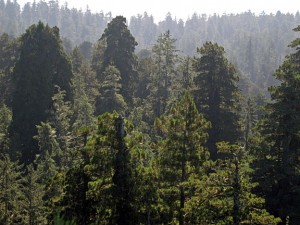
People are cloning the world’s oldest redwoods. Archangel Ancient Tree Archive is planting their clones en masse around the world in an effort to create robust forests of the future. They say these ancient clones will reverse deforestation across the planet and combat climate change in the process. These are lofty claims and they have me worried.
I’m an advocate of reforestation, but as a conservationist and scientist I question why redwoods, why clones, and why now? Global reforestation with redwoods sounds like a great idea on the surface. After all, redwoods have the potential to capture and store a tremendous amount of carbon dioxide (1) – the primary gas causing global warming. But nothing happens in a vacuum. Instead of forests with native trees, the redwood clones will create exotic plantations. Some wildlife, like birds, need their own native tree species to thrive (2) and creating alien forests will not restore the habitat they’ve lost.
Even in the natural redwood range, redwood plantations may be risky because clones may spread their gene copies into wild populations over time and therefore lower genetic diversity. Archangel plants only clones of the oldest redwoods because they view them as superior trees that have withstood the test of time. These ancient redwood monarchs thrived in a markedly different world than the one redwood seedlings of today will face in the next millennium. Archangel assumes that a clone of the last ancient is better suited for the future than a young seedling with a new combination of genes. How presumptuous! The truth is we don’t know which is better suited for uncertain future conditions and it’s a gamble to pretend we do. Reducing genetic diversity just as the redwood forest faces one of their greatest ever challenges is short-sighted at best, and at worst poses significant risk for the future of the forest.
I think the smartest approach is to let genetic diversity remain high in our forests and let natural selection pick the best trees of tomorrow. So yes, the time is now to halt deforestation and support reforestation. And yes, the redwoods can play a role. But so too should the oaks, and sycamore, and eucalyptus, and the rich variety of trees and forests around the planet that soak up carbon dioxide in their native forests and provide a rich and varied habitat for the world’s plants and animals, and inspirational places for all people to enjoy.
On this Arbor Day, let’s celebrate trees and think carefully about how we use them. What do you say?
(1) Sillett, S. C., Van Pelt, R., Koch, G. W., Ambrose, A. R., Carroll, A. L., Antoine, M. E., & Mifsud, B. M. (2010). Increasing wood production through old age in tall trees. Forest Ecology and Management, 259(5), 976-994.
(2) Ikin, K., Knight, E., Lindenmayer, D. B., Fischer, J., & Manning, A. D. (2012). The influence of native versus exotic streetscape vegetation on the spatial distribution of birds in suburbs and reserves. Diversity and Distributions.

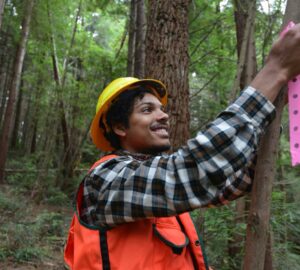
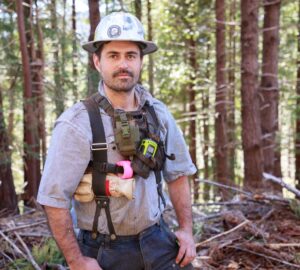



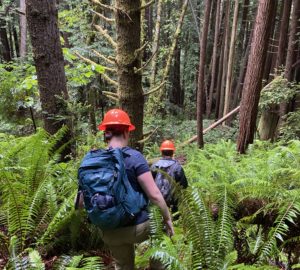
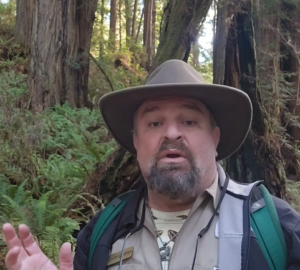

13 Responses to “Clone the best, forget the rest?”
Roger Beaudoin
Humm, 2013 is so long ago…. I read David Milarch’s book while reading various books about NDE (near death experience). The man was told by the angels in charge of trees to go back to save the genetics of the oldest trees before they were all gone and save them for the future. Now given the logging of most of the last remaining great redwoods in the 80s and 90s to pay of junk bonds and now global warming and historic megafires in both costal and giant redwoods groves in the summer and fall of 2020, seems like it is not such a bad idea. Like the seed vault. I do not believe that the forests of Germany are in danger of armys Davids clone trees. The idea is to have a library of the genetics of some of these old trees around the world in case the one forest (CA/OR) they exist in gets wiped out. Sounded far fetched in 2013, but after this year I feel that it is not inconceivable that the redwoods could really be endangered by global climate change and megafires…A few libraries of champion trees are not a threat to anybody and may save the species, the angels think so…
M. D. Vaden
Relating to this topic, something new was found this autumn 2016 that further shows that the largest redwoods stem from conditions, not particularly super-DNA. A spring was found by one of the new largest coast redwood discoveries this autumn, more or less explaining how it could attain that size when we had questions about where it got it’s moisture.
Gerald Beranek
Logging certainly disseminated the old growth redwoods. I seen it first hand here since my childhood in the 50’s to present day. Thanks to Save the Redwoods and so many other conservation groups what’s left is preserved.
Though I would not called what is left “the small and the weak.” Maybe weak in the sense of the amount left, but not in the strength of these trees to show us what they capable of achieving.
Through vegetative reproduction (second growth redwood clumps) the gene pool of the old growth redwoods lives on vigorously today, and it is a most wonderful strength of this tree.
Logging changed the landscape drastically and turned the old-growth redwood forest into a second-growth redwood habitat. Yet every acre of logged over ground that was let to grow wild is still growing redwoods today, and we can thank our lucky stars.
The redwood is strong and will live on to take reign as the dominant species in its habitat once again.
M. D. Vaden
Gerald, I revisited this topic today to share about a spring, related to the subject. Since I noticed your posts and reviewed them, it seemed worth encouraging other readers if they have a chance, to keep an eye out for your new redwoods books. Online of course, but the Humboldt Redwoods SP is another place to hold and preview a copy. At least the last time I stopped in.
Luke
I understand not wanting to breed a monoculture of a small number of Redwood genomes, but something has to be done to reverse hundreds of years of what logging enforced, i.e. logging enforced the opposite of survival of the fittest. Logging went after the biggest and strongest trees, leaving the small and weak. If you kill the strong and keep the weak for a couple hundred years, the genetics of a population are moved in the wrong direction. Hopefully Archangel can give things a push in the right direction, by helping propagate the genes of the strongest trees that would have propagated their genetics, if not for the logging industry.
Sushi
I agree! Very good point. But much diversity of the giants too needs to be applied to process.
John
Cyndy,
a few things:
1. Cutting down all non-native trees is both unnecessary and irrational, since they provide desirable ecosystem services, and when housed in arboretums, they are important resources for scientists and help to conserve endangered species. Nowhere does Dr. Burns advocate the removal of non-native taxa. The landscape in CA has been almost completely transformed by non-natives so this is moot. Her argument is that planting redwood clones en masse in places where they have not been endemic over at least the past 400, 000 years is problematic for the reasons she outlined above. Besides, the climate these species evolved in is vastly different than what we’re headed for in the Pacific Northwest so it’s unclear by what criteria Archangel deem their clones most suitable to a particular habitat. As someone familiar with the physiology of redwoods and their relatives, I would argue that planting junipers is the best approach given the frequent drought events experienced in the Western. Alternatively, how about we plant redwoods in southern Florida or the sub-tropics of South America?
Unlike Save the Redwoods League, Archangel has no scientific directorate to guide its selection of species and individuals for cloning despite the many experts who have published in this field. This is a non-collaborative, rogue approach. Planting clones en masse disrespects the inherent qualities of the ecosystems in which these trees will be grown, and is completely contrarian to the conservation missions advocated by agencies such as SRL, The Nature Conservancy and probably many others.
2. The ‘magnificent’ Monterey Pines are invasive in New Zealand. The can be found in regions far from where they were originally planted and aside from outcompeting native vegetation dominated by tree ferns and Podocarp conifers, they are completely out of place and an eyesore. Per the land care managers in NZ (I happen to know several), managing these trees is costing them both time and resources. They are a nuisance outside of their intended plantations.
3. Clearly, the definition of ‘conservation efforts’ is elastic. By growing redwood trees in your backyard in East Bay or Marin for example, you could be called a conservationist, and that’s good. However, rather than cloning trees like Archangel, SRL chooses to preserve large tracts of redwood forest. Concurrent to this are efforts to identify drought-tolerant and/or fast-growing varieties that can be used for rehabilitation purposes. Scientists at institutions such as UC Berkeley and UC Santa Cruz are participating in these strategic studies because targeted re-planting based on some understanding of the physiology of the native flora is more likely to maintain ecosystem integrity (and thus tree health) rather than the random planting of clones based on ideology of how trees should function.
4. The scientific and conservation efforts of SRL are of tremendous benefit to the conservation of these large trees, and Dr. Burns and the scientific advisory board are extremely competent in serving the mission of this organization. While your “lifetime of experience” of working with and in the redwoods is commendable, the tenor of your post is not, as evidenced by: “..my dear Emily…” “wake up and open your young eyes’ , “you sound like a quite closed-minded, self-proclaimed expert”. In your future posts, please refrain from posting these judgmental statements.
Thank you.
Gerald Beranek
The redwood once covered over two-thirds of the northern hemisphere. Fossil evidence of their once vast range abounds. With planting and introduction they may gain some of that back. And I believe it would be a good thing to do in some places. A big experiment? Yes!
While redwoods do proliferate vigorously from stumps sprouts, as our second growth forests clearly show, the main mode of reproduction in the old growth habitat comes by seed, not sprouts. Not surprising, second growth sucker clumps are clones of the old growth redwoods that were clear cut. So the genetic diversity of the old forest is still alive today.
Cyndy
What is wrong with planting redwoods in other locations?
Do you think we should cut down every eucalyptus in California? They are not native!
Should we cut down all non-native trees across the United States? Cut down trees in arboretums, because they are non-native?
Have you heard about the magnificent Monterey Pines trees grown in New Zealand? Oh, non-natives, they shouldn’t be grown in a non-native location. Is that how you think?
Some how, my dear Emily, I think you should re-read Tim’s comments: “As a conservationist, and all the above things you stated that you are you should be happy that people are putting in their time and effort to do something like this and learn even more about redwoods and how they can be micropropagated.”
You sound like a quite closed-minded, self-proclaimed expert on redwoods and cloning.
Wake up, Emily, and open your young eyes. There are many, many of us who have spent a life-time working in and studying redwoods, and some of us don’t agree with you!
Yes, Tim is correct, your use of the bold sections was totally unnecessary!
Emily Burns
M.D. Vaden, you make a great point and this is all a big experiment. It will be interesting to see which trees do the best in the centuries ahead.
M. D. Vaden
Since you asked …
At least Archangel is bringing some extra enthusiasm to the picture with their work and experiment.
Personally, I don’t think the biggest trees they clone from will really produce trees that grow faster or better than had they cloned from other younger trees, especially younger ones that could have been observed as growing exceptionally over several years or more.
Odds are, that in the space of history, their clone stock may as well be recent history.
If I were going to try something like their cloning, I’d select differently. For example, in Prairie Creek, there’s a monumental redwood “Spartacus” that looks very youthful for a tree with a 20 foot diameter trunk. Very streamlined trunk for the first 100 feet. I’m guessing, but I think it may be younger for it’s size comparatively. What’s unique, is how it’s on a hillside, which is not common for a 20 footer. And it’s over 300 feet tall.
That’s the kind of tree I’d be thinking of cloning.
Otherwise, I’m happy with growing cute little seeds.
Emily Burns
Thank you very much for your comments and feedback, Tim. We’re always excited to have a lively debate about conservation issues, and you raise some great points. Let me address a few of them:
Let me begin by saying that Save the Redwoods League does indeed support replanting forests after clearcutting, and in fact we do a lot of it ourselves. Our approach is to use seedlings grown from several local sources, in order to both maintain the genetic diversity of the forest and to ensure that the newly planted seedlings have a genetic makeup naturally selected for the environment in which they are planted. Redwood trees certainly do reproduce via sprouting from burls, but these sprouts grow only where the original tree grows. The Archangel project proposes to plant redwood trees not only in California and Oregon, but also in Germany, Ireland, Wales, Great Britain, New Zealand, and Australia. Redwoods are not native to these places, and the creatures that have evolved with forests dominated by spruce, oak, eucalyptus, or kauri trees may not be able to survive in redwoods forests. The motto of Archangel Ancient Tree Archive is “the right tree, in the right place, for the right reason.” Coast redwood is certainly the right tree in the right place in many areas of California, and even for some small parts of Oregon, but we do not believe it is the right tree for the native forests of Germany, Ireland, or Australia.
We are also concerned with the focus on cloning only the largest trees for propagation. The giants of the redwood forest are surely remarkable, true wonders of the world, but they represent only a tiny fraction of the diversity of the species and of the forest. There is so much we don’t know about the forest, including which trees will be best suited to meet a rapidly changing climate in the future. By cloning only from a few select trees, the genetic diversity of the planted forest will be extremely low. Here at the League, we are interested in conserving the full range of the genetic diversity of the redwoods, and would encourage replanting efforts to focus on local source stock, gathered from a number of different trees, in order to provide that vital diversity. Genetic conservation is essential to protecting nature, but it means much more than only preserving the biggest and oldest trees.
We are very happy that you are so interested in conservation and reforestation, and we hope that you continue to contribute to the dialogue on these issues.
Tim
I do not agree with this blog. I also find the bold sections to be unnecessary. I’m not affiliated with them at all but do you follow the archive? They planted their redwoods in an area of Oregon which had been clear cut. I don’t get how you can say that they are creating this invasive problem when they are not. Where are they planting them that they shouldn’t? You don’t say. Redwood trees reproduce through clones of themselves more so than their seed. All you have to do is see a burl to know that. Your argument about diversity is just plain wrong, it’s not like all the clones they are planting came from the same mother. As a conservationist, and all the above things you stated that you are you should be happy that people are putting in their time and effort to do something like this and learn even more about redwoods and how they can be micropropagated.